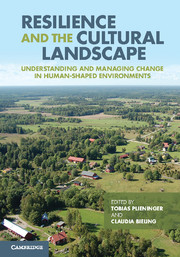 Resilience and the Cultural Landscape
Resilience and the Cultural Landscape Book contents
- Frontmatter
- Contents
- List of contributors
- Preface
- Part I Conceptualising landscapes as social–ecological systems
- 1 Connecting cultural landscapes to resilience
- 2 Landscapes as integrating frameworks for human, environmental and policy processes
- 3 From cultural landscapes to resilient social–ecological systems: transformation of a classical paradigm or a novel approach?
- 4 Conceptualising the human in cultural landscapes and resilience thinking
- 5 System or arena? Conceptual concerns around the analysis of landscape dynamics
- 6 Resilience thinking versus political ecology: understanding the dynamics of small-scale, labour-intensive farming landscapes
- Part II Analysing landscape resilience
- Part III Managing landscapes for resilience
- Part IV Perspectives for resilient landscapes
- Index
- References
5 - System or arena? Conceptual concerns around the analysis of landscape dynamics
Published online by Cambridge University Press: 05 November 2012
- Frontmatter
- Contents
- List of contributors
- Preface
- Part I Conceptualising landscapes as social–ecological systems
- 1 Connecting cultural landscapes to resilience
- 2 Landscapes as integrating frameworks for human, environmental and policy processes
- 3 From cultural landscapes to resilient social–ecological systems: transformation of a classical paradigm or a novel approach?
- 4 Conceptualising the human in cultural landscapes and resilience thinking
- 5 System or arena? Conceptual concerns around the analysis of landscape dynamics
- 6 Resilience thinking versus political ecology: understanding the dynamics of small-scale, labour-intensive farming landscapes
- Part II Analysing landscape resilience
- Part III Managing landscapes for resilience
- Part IV Perspectives for resilient landscapes
- Index
- References
Summary
Introduction
An important challenge in the quest for sustainable development is to understand and manage changes in the physical landscape. It is widely acknowledged that this has to be achieved within a multidimensional framework where human well-being, species, biodiversity and many other values are recognised (MA, 2005). In order to enhance social and ecological responsible governing, analytical tools are needed that can identify potentially problematic trends as well as contribute to the formulation of effective management strategies. In this context the importance of national and global perspectives is indisputable – but not sufficient. If one includes material and immaterial features and processes, and considers the unique constellations of these at different sites, strategies for sustainable development must, by necessity, reflect local variation. This is even more apparent as drivers of land use change operate at various spatial, temporal and institutional scales, and also with their influence differing depending on local socioeconomic and biophysical characteristics (further developed by Bürgi et al., Chapter 7; Eiter & Potthoff, 2007). Therefore, the success of managing change will, to a large extent, depend on considerations made by local authorities in their comprehensive planning for specific areas, as expressed in the Rio Declaration on Environment and Development. This calls for a qualified understanding of the integrated relationship between social and ecological aspects also from a more narrow scale perspective.
‘Social–ecological systems’ is a concept used to frame an integrated perspective that links human society and nature commonly applied within resilience thinking (or resilience theory). Although it has become widely used since its introduction in the 1990s, the concept is still considered to be in an exploratory phase, where one of the key challenges is to come to grips with complexity (Cumming, 2011; Ostrom, 2009). The concept departs from an explicit system approach, where concepts are characteristically generated mainly from theory, and interrelationships are based on extrapolations and generalisations, rather than on vicinity and physical affinity (Törnqvist, 1981). However, studies employing the concept of social–ecological systems often relate to specific case studies, that is, investigations of specific areas of a limited size (Berkes & Folke, 1998; Berkes et al., 2003), and the concept thereby assumes a spatial definition. In this way, social–ecological systems show apparent overlaps with conceptualisations of landscape, most notably with the spatial landscape perspective within geography (Olwig, 2007).
- Type
- Chapter
- Information
- Resilience and the Cultural LandscapeUnderstanding and Managing Change in Human-Shaped Environments, pp. 80 - 94Publisher: Cambridge University PressPrint publication year: 2012
References
- 4
- Cited by


